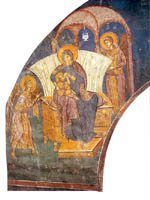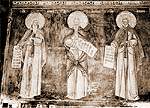
 |
  |
The
Patriarchate of Pec:
|
 |
|
The
narthex, Dynasty of the Nemanjic, fourth decade of the 14th century
|
The narthex in front of the three churches was built by Archbishop Danilo II at the beginning of the fourth decade of the 14th century. Its construction is described in considerable detail in his biography. It is specifically mentioned that his wish was to build a narthex "worthy of much talk". It is also mentioned that he built a "cathecumena" above the narthex, as well as a large tower in front of the church, which contained a small church dedicated to the founder's namesake Daniel Stylite. On the top of the tower bells were installed, which had been brought, on Danilo's orders, from a foundry on the Adriatic coast. Today only the foundations of this tower are visible, but the narthex is in a fairly good state of preservation. Its picturesque form, daring in design, but, naturally, with abbreviated details, can be seen on the founder's portrait of Danilo II in the Church of the Virgin.
Designed as a luxurious porch, the narthex was open on three sides. Because of its large span there were five supports in its interior - two columns and three pillars - upon which the structure of the vault rested. This narthex with slender marble pillars, spacious, well lit, decorated with frescoes both inside and outside, was greatly admired. It is mentioned in an old genealogical work as one of the most beautiful achievements of the art of the past centuries: "The floor of the Prizren church, the church at Decani, the narthex of Pec, the gold of Banja and the scribal work of Resava, are nowhere to be matched."
 |
|
The
narthex, the Virgin, fourth decade of the 14th century
|
We can only imagine, however, the beauty of the original narthex. During the restoration of the Patriarchate of Pec about 1560, the arch openings on the external facades had to be walled up because of structural reasons and decay. This saved the Pec narthex from falling into ruins, but it affected greatly its architectural design. The efforts of conservation experts in recent times have not been successful in improving the rather unattractive facades of the narthex, especially since there are 16th-century frescoes on the internal surfaces of the walls filling the arch openings, which must be preserved.
A baptismal font, made of reddish marble, was placed, as was the custom in churches, in the south-west comer of the narthex. Much of it is now missing, so that its original appearance cannot be reconstructed. The marble "Throne of St. Sava" is placed against the eastern wall, near the entrance to the Church of the Apostles. The Serbian archbishops and patriarchs sat on this throne when they presided over ecclesiastical assemblies held in the Pec narthex.
Patriarch Makarije, the second founder of the narthex, was buried here. His figure, with the model of the narthex, is shown on the front side of a pilaster on the east wall, but much of it was re-painted in 1903. He addresses a prayer, written on a scroll, to the Virgin and Christ, shown on the adjacent pilasters.
Very little has survived of the original frescoes which decorated the narthex at the time of Archbishop Danilo II. All of them are in the south-east corner, predominantly on the east wall. Although few in number, they are very interesting as regards their subject matter.
 |
|
The
narthex, three saints monks, 1565
|
Especially remarkable is the Tree of the Nemanjic on the east wall, near the lateral, south entrance to the narthex. It shows the members of the dynasty from its founder Stefan Nemanja (Simeon of Serbia) to the then living King Stefan Dusan. They are arranged four horizontal rows. It is obvious that the greatest emphasis is laid on the vertical zone in the middle, which shows, from bottom to top, Stefan Nemanja, Stefan the FirstCrowned, Uros I and King Milutin, with his son Stefan Decanski and grandson Dusan (still a king at that time) at his side. In addition to these portraits, there is also a painting of the founder, Danilo II, represented as a fairly young man above the entrance to the Church of the Virgin. He pays homage, together with St. Nicholas, to the monumental figure of the Virgin, who is represented as the Fountain of Life. Especially rare among the individual 14th century figures is the Virgin painted on the south wall. The Virgin is shown on this painting as a loving mother giving suck to her son.
These frescoes are the work of two masters. One of them has an indifferent sense of colour and neglects the treatment of the uncovered parts of the body. The other artist, whose work is predominantly in the lower zones, is a better draughtsman and tends to emphasise the volume of his figures.
The facades of the narthex were mostly painted at the time when the narthex itself was adorned with frescoes, i.e. about 1330. These wall paintings are greatly damaged, but some figures of individual saints, and even whole compositions, can be distinguished. The paintings on the south side of the narthex, below the original porch which has disappeared now, include a scene showing the birth of a saint.
 |
|
The
narthex, Last Judgement and Expulsion of Adam and Eve from Paradaise,
1565
|
Approximately half a century later, before 1375, an unusual figure of St. Sava of Serbia was painted on the pilaster near the entrance to the Church of the Apostles, above the "Throne of St. Sava" The first Serbian archbishop is shown here as a patriarch and wears ceremonious robes and an ornate mitre. This neglect of historical truth was a deliberate act of the first Serbian patriarchs in their efforts to elevate the founder of the Serbian independent church and also a reflection of the struggle waged with Constantinople over the recognition of the Patriarchate of Serbia.
Apart from the 14th century frescoes in the south-east comer of the narthex and the above mentioned figure of St. Sava, all the other frescoes in the narthex were painted in 1565, soon after the Serbian Church organisation had been restored and the Patriarchate of Pec had become its centre again. The inscription concerning the restoration, above the small door in the north wall, informs us that the founder was Patriarch Makarije and that it was done in 1565 (not in 1561, as was the former reading of the faded inscription)
The repertoire of these wall paintings is very rich. The first zone shows a number of distinguished monks, including on the north side of the west wall, the well-known Balkan hermits Petar Koriski, Prohor Pcinjski, Jovan Rilski Joakim Sarandaporski, Gavrilo Lesnovski and Joanikije Devicki. Some Serbian archbishops and patriarchs from the time of the independent Serbian state are represented on the north and east walls. Balkan anchorites and Serbian ecclesiastical leaders are included into the subject matter of the paintings in the Pec narthex in order to emphasise the comprehensiveness of the Serbian church organisation and the renown of its saints. The other figures and compositions in the narthex conform to the established themes of large buildings of this type: the eastern section contains, on the vaults and beneath them, a representation of the Calendar - 365 figures and scenes, one for each day of the year. Seven oecumenical councils, a local one, held in the time of Emperor Honorius, and, near them, the Council of Simeon of Serbia, are represented on the vault surfaces in the north part of the narthex. The west section of the narthex contains compositions which illustrate Christ's life, teachings and parables. They are arranged in groups, following a learned theological pattern associated with the liturgical rite and the readings from the Gospels during the service.
These 16th century paintings are inferior to the 13th and 14th century frescoes in the Patriarchate of Pec. However, they may be numbered among the most important achievements of the painting of that time. They were painted by masters engaged by Patriarch Makarije and his collaborators in the restoration of the Patriarchate. Andreja, one of these artists and probably their leader, signed his name on the shield of St. Demetrius above the entrance to the church dedicated to that saint. Longin, a monk from Pec and the most famous Serbian painter of the second half of the 16th century, also worked with the painters who adorned the Pec narthex.
The frescoes in the Pec narthex are competently drawn, the composition of the scenes is sometimes skilful, and their colour scheme is simplified. Viewed as a group, these wall paintings are very close to the early 14th century frescoes in K and iconography. It was a deliberate tendency of the founder Patriarch Makarije, as well as of Andreja and his assistants to look for models in the works from the period of the greatest ascendancy of the Serbian state.
Two figures, St. Angelina and Archangel Michail, dating from 1875, have been preserved on the west wall near the main entrance to the narthex. They represent parts of a major undertaking, when some of the earlier frescoes in the narthex and, particularly, in the Church of the Apostles, were covered with wall paintings of inferior quality.
History
/ People / Spirituality
/ Churches / Arts
/ Links
Main page / Serbian